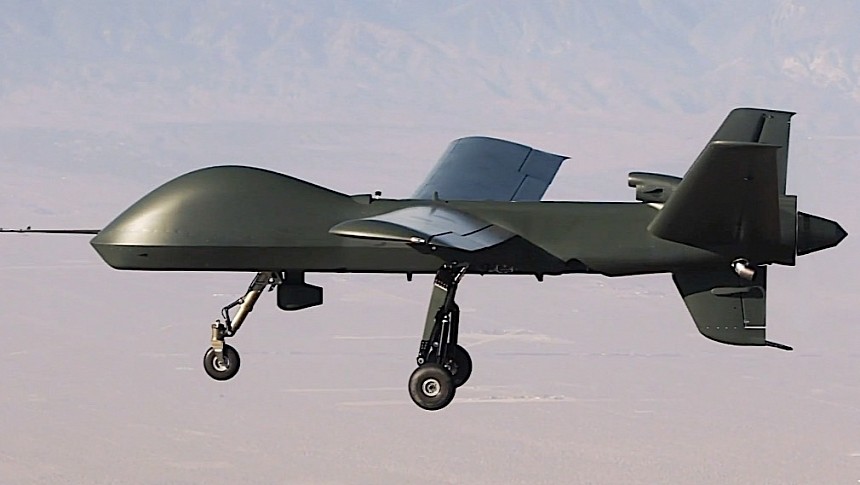The Royal Navy calls its newest aircraft carrier, the HMS Prince of Wales (R09), the most powerful surface warship ever made in the country. In recent months, it has also become the favorite place for various military contractors and branches to test their gear and skill.
Last we heard of the ship's exploits was back at the beginning of the month. Then we learned of a pilot with the U.S. Marine Corps having landed an F-35B using a method never attempted before on the ship: night rolling vertical landing (SRVL).
The British carrier once again comes into the spotlight this week after American defense contractor General Atomics announced something it describes as a "first-of-its-kind demonstration" of the Mojave unmanned aircraft system (UAV).
The drone is perhaps the newest of its kind in the world, having had its first flight back in 2021. An offshoot of the MQ-9 Reaper and MQ-1C Gray Eagle, hence a member of the Predator family, it's meant to be first and foremost a new set of eyes in the sky, and secondly, an armed aerial platform – or armed overwatch, as General Atomics calls it.
The Mojave was initially envisioned as a tool meant to prove that short takeoff and landing (STOL) drones can operate out of unprepared landing sites. It is now used as a test bed to inform STOL wing set options for the other members of the Predator family, namely the SkyGuardian, SeaGuardian, and Protector.
Aside from its departure and arrival capabilities, the Mojave sets itself apart through the large payload capacity. It can carry 3,600 lb. (1,633 kg) of cargo, which in weapons would translate to a total of 16 AGM-114 Hellfire missiles.
The drone is powered by a Rolls-Royce turboprop engine that develops 450 shaft horsepower. It can move to distances as large as 2,900 miles (4,600 km), and can stay airborne for 24 hours.
Why are they testing a STOL and not a regular kind of drone on this warship? You see, the most modern of aircraft carriers, Prince of Wales included, are not designed with regular take-off and landing surfaces, and they lack catapults and arrestor wires. That's why, for instance, the achievement of the F-35B earlier this month was so important.
And so is what the Mojave managed to do. Controlled by pilots seated on the British ship, the drone took off, circled the ship, approached, and landed back onto the deck, proving both the aircraft's design and the way the R09 was made work together as advertised.
The test occurred on November 15, when the aircraft carrier was off the East Coast of the U.S.. It was, according to Rear Admiral James Parkin, Royal Navy's director of development, a European first: "the first time that a Remotely Piloted Air System of this size has operated to and from an aircraft carrier outside of the United States."
The British carrier once again comes into the spotlight this week after American defense contractor General Atomics announced something it describes as a "first-of-its-kind demonstration" of the Mojave unmanned aircraft system (UAV).
The drone is perhaps the newest of its kind in the world, having had its first flight back in 2021. An offshoot of the MQ-9 Reaper and MQ-1C Gray Eagle, hence a member of the Predator family, it's meant to be first and foremost a new set of eyes in the sky, and secondly, an armed aerial platform – or armed overwatch, as General Atomics calls it.
The Mojave was initially envisioned as a tool meant to prove that short takeoff and landing (STOL) drones can operate out of unprepared landing sites. It is now used as a test bed to inform STOL wing set options for the other members of the Predator family, namely the SkyGuardian, SeaGuardian, and Protector.
Aside from its departure and arrival capabilities, the Mojave sets itself apart through the large payload capacity. It can carry 3,600 lb. (1,633 kg) of cargo, which in weapons would translate to a total of 16 AGM-114 Hellfire missiles.
The drone is powered by a Rolls-Royce turboprop engine that develops 450 shaft horsepower. It can move to distances as large as 2,900 miles (4,600 km), and can stay airborne for 24 hours.
Why are they testing a STOL and not a regular kind of drone on this warship? You see, the most modern of aircraft carriers, Prince of Wales included, are not designed with regular take-off and landing surfaces, and they lack catapults and arrestor wires. That's why, for instance, the achievement of the F-35B earlier this month was so important.
And so is what the Mojave managed to do. Controlled by pilots seated on the British ship, the drone took off, circled the ship, approached, and landed back onto the deck, proving both the aircraft's design and the way the R09 was made work together as advertised.
The test occurred on November 15, when the aircraft carrier was off the East Coast of the U.S.. It was, according to Rear Admiral James Parkin, Royal Navy's director of development, a European first: "the first time that a Remotely Piloted Air System of this size has operated to and from an aircraft carrier outside of the United States."









